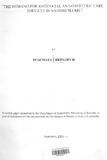| dc.contributor.author | Chepkoech, Rosemary | |
| dc.date.accessioned | 2013-05-04T07:23:49Z | |
| dc.date.available | 2013-05-04T07:23:49Z | |
| dc.date.issued | 2003 | |
| dc.identifier.uri | http://erepository.uonbi.ac.ke:8080/xmlui/handle/123456789/18879 | |
| dc.description.abstract | The general performance of Kenya's health sector has been varied, with infant mortality
rate increasing from 64 per 1,000 in 1993 to 72 per 1,000 in 1998. It is estimated that 36
per cent of the children die before reaching their fifth birthday. Maternal mortality also
remained high and was estimated at 590 per 100,000 births in 1998. Antenatal care
provides an opportunity for a variety of preventive interventions during pregnancy. It also
allows women who face a high-risk pregnancy to be identified and monitored to ensure a
safe delivery. Obstetric care is an important aspect of maternal care.
The urban slums of Nairobi have poor sanitary conditions, low level of safe drinking
water and lack toilet facilities. Because of the existing environmental conditions in the
slums, the health status of women could be aggravated by under utilization of antenatal
and delivery services. The objective of this study was to investigate the determinants of
utilization of antenatal and delivery care services in Nairobi slums and to assess the
relative importance of the factors affecting the choice and utilization of antenatal and
delivery care services.
The decision to use or not to use antenatal care is analyzed using the logit model. The
multinomiallogit model is used in the analysis of choice of different places of delivery.
The intensity of using the antenatal care services is analyzed using the two stage least
squares method. Primary data was collected from a sample of 205 women living in four
slums of Nairobi Province.
The results show that higher family income increases the demand for both antenatal and
delivery care services. An increase in income also raises the intensity of using the
services. Education of women increases the demand for antenatal and delivery care
services. The cost per visit as well as the distance traveled to the facilities significantly
reduces demand for these services. Examination time was found to affect the demand.
Another important finding is that most women ir! the slums depend on public facilities for
both antenatal and delivery care services. The policy implications of the results are
briefly discussed. | en |
| dc.description.sponsorship | The University of Nairobi | en |
| dc.language.iso | en | en |
| dc.subject | Antenatal and obstetric care Service | en |
| dc.subject | Nairobi slums | en |
| dc.title | The demand for antenatal and obstetric care Services in Nairobi slums | en |
| dc.type | Thesis | en |
| local.publisher | Department of Economics | en |

